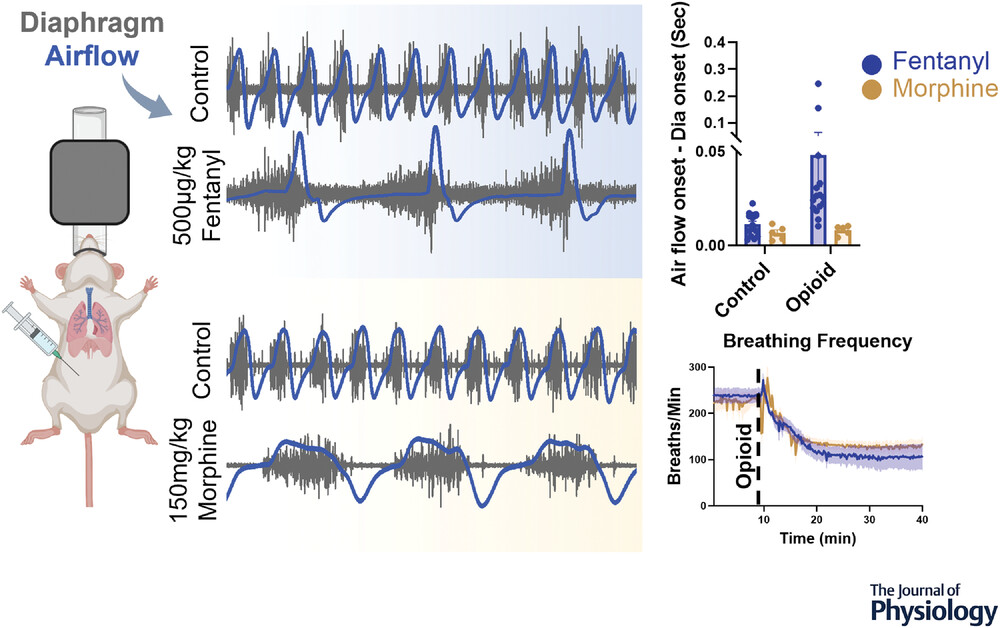Drug overdose deaths claim the lives of around 600,000 people around the world each year, these statics include both medical and recreational drug use. Opioids are notably at the forefront of drug overdose-related deaths with the primary cause of death a reduced ability to breathe. To improve health guidelines around opioids and reduce deaths from overdoses, it is important to understand what effects different opioids have on our airways.
To start to answer these questions, a group of researchers explored the physiological implications of two opioids, morphine and fentanyl. Dr Nicholas Burgraff, Seattle Children’s Research Institute, US, who led the study, explains how their research can improve guidelines and help reduce death from opioid use.
Opioids and respiratory depression
The primary cause of death from opioids is a reduced ability to breathe, which is often termed opioid-induced respiratory depression. This happens due to opioids inhibiting the brain’s signals to the respiratory system and restricting the smooth passage of air through the airways.
Opioid-induced respiratory depression is a significant health concern, given its prevalence and fatal consequences from an otherwise transformative group of drugs. Indeed, opioids are potent analgesics that offer pain relief to millions globally, but can lead to addiction, opioid dependence, and desensitisation.
How do you study the effects on the body?
We know that opioids inhibit the brain’s signals to the respiratory system, so we want to identify the neural networks and mechanisms within the brainstem that can counteract or reverse this respiratory effect. As we began uncovering the mechanisms, we realised that we had to expand our approach to encompass both the central nervous system and the peripheral network of nerves that branch out from the brain and spinal cord to understand how the opioids affect the airways and the vocal cords.
We hope that our findings will highlight that innovative treatments targeting this condition should not only address the suppression of the central neural system, but also consider peripheral interventions to overcome all aspects of opioid induced respiratory depression.

Do different opioids have the same effect on our ability to breathe?
While much of the existing literature has used morphine or morphine-based opioids to investigate their effects on respiratory systems, in our research, we chose to include fentanyl, given its prevalence in overdose cases, to create a more translational research approach.
Both morphine and fentanyl are potent opioid analgesics, altering how the brain perceives pain. However, fentanyl represents most overdose fatalities and has a potency approximately 100 times that of morphine. Yet, potency alone doesn’t explain the heightened risk of death. Therefore, we investigated whether fentanyl’s impact on the respiratory system differs from morphine, potentially elucidating its increased mortality risk.
When administered at an equivalent dosage, fentanyl leads to a more pronounced suppression of breathing because of its higher potency compared to morphine. Yet, when the doses are adjusted appropriately, both fentanyl and morphine suppress central brainstem respiratory activity to the same degree. Additionally, both decrease the blood levels of oxygen in the arteries, reduce heart rate, and diminish the frequency of physiological sighs (a controlled breathing pattern the body uses to calm itself in response to stress), which may be crucial in preventing lung collapse.
When we administered adjusted doses of both opioids to achieve comparable suppression of breathing, only fentanyl constricted the airway. We also observed that survivability under low-oxygen conditions, similar to those during an overdose, was markedly reduced after fentanyl administration compared to morphine.
How can this clinical research help develop potential therapies?
Understanding the distinct respiratory effects across opioids is crucial for developing therapeutic strategies against overdoses. While highlighting these specific differences is important in cases with known drug complications, where the type of opioid used is controlled, it may be more effective to develop broad-spectrum therapeutics capable of countering all opioids.
This is especially true given that outside clinical settings, opioid administration often lacks control. Our research emphasises the importance of integrating peripheral-based treatments, such as those targeting the airways, to establish a comprehensive approach to combat opioid overdose.
What are the next steps to developing therapeutic guidelines?
Our mouse model is a key step in the translational journey towards devising therapeutic strategies against opioid overdose. We used invasive techniques, uncovering physiological events that might otherwise be elusive in human study participants. In line with our translational approach, we assessed two FDA-approved bronchodilators (a medication to help ease breathing by widening the airways), commonly prescribed for asthma and allergic airway constriction, as potential therapeutic interventions.
Both proved effective in reversing opioid-induced airway issues, indicating their potential for clinical application. Given their established use in treating other respiratory complications, we propose their combination with standard opioid antagonists like naloxone. This approach could reduce the required naloxone dosage and counteract adverse effects often seen from rapid opioid reversal.
To read the full analysis of the distinct consequences of morphine and fentanyl, the article is published in The Journal of Physiology.
